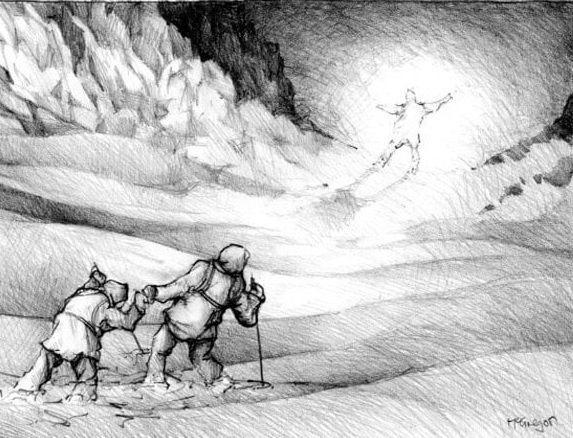Nandi Bear: A Ferocious African Cryptid
An artist's interpretation of the Nandi Bear. Photo: Cryptid Archives.
The Nandi Bear is a ferocious cryptid spotted in the highlands of Kenya during the 19th and 20th centuries.
Description of the Nandi Bear
A footprint of a Nandibear
The Nandi Bear is also known as the Chemosit, Kerit, Koddoelo, Ngoloko, or Duba. It has been described as as a carnivorous animal with a formidable build, possessing long legs exceeding a height of four feet, and a back that slopes downward. It is described as being highly aggressive in nature.
Nandi Bear Sightings
A drawing of a Nandi Bear encounter by A. McWilliams
A number of early 20th century authors mention the Nandi Bear in their work.
Richard Meinertzhagen claimed in 1905 that he was told by the Nandi people that the Nandi bear was once widespread when they first settled in the highlands of present-day Kenya, around the early 17th century.
The Nandi people believed that the rinderpest epidemic towards the end of the 19th century pushed the Nandi bear to the brink of extinction. Although the Nandi bear was never numerous, it was not uncommon prior to the epidemic.
Unfortunately, the population never fully recovered from the impact of the outbreak. During the colonial era, the Nandi bear was held responsible for the deaths of numerous native people, whose skulls were found crushed every year.
While the Nandi Bear was widely feared by the native population, it does not appear to have been known to Europeans or colonial officials until the beginning of the 20th century.
Prior to 1912, the Nandi reportedly killed a Nandi Bear after it climbed onto the roof of a hut, broke through, and killed everyone inside. Subsequently, the village inhabitants burned down the hut with the animal still inside. Geoffrey Williams had heard of a similar animal's preserved skin in Kabras, but was unsuccessful in obtaining it.
There were rumors that a Boer had shot a Nandi bear, but was unable to retrieve the carcass. C. W. Hobley wrote of this story.
Similarly, a farmer from Uganda named K. R. Williams supposedly unintentionally poisoned a young Nandi bear while setting out bait for hyenas.
Williams described the animal as being much larger than a spotted hyena, with the same yellowish fur, and a head similar to that of a bear. However, when he returned to his camp to retrieve a knife for skinning the carcass, actual hyenas had dragged the Nandi bear's body away.
In 1905, while on the Nandi Expedition to the Uasin Gishu in western British East Africa, Geoffrey Williams wrote of his experiences with the Nandi Bear.
He observed an animal of around 5 feet in height sitting upright like a zoo bear, with small pointed ears and a long head, about 30 yards away.
The creature then ran away with a sideways canter towards the Sirgoit Rock. Williams quickly took a snapshot of the animal with his rifle, but missed it.
He claimed the Nandi bear was larger than a typical zoo bear and heavily built, with thick fur covering its forequarters and all four legs. The hindquarters were relatively smooth, and the color was dark.
Williams could not recall much about the ears, but mentioned that they were small, and the tail, if any, was tiny and barely noticeable.
Engineer Dennis Burnett and his wife Marlene reported the most recent documented sighting of the Nandi bear in February 1998.
While driving along the Koru-Kisumu road near the base of the Nandi Escarpment during a rainy evening, they saw a large animal crossing the road.
Upon reversing their car, the couple observed the animal for about fifteen seconds. Although they initially thought it was a bear, they soon realized that it was "an enormous, shaggy hyena – resembling a Striped Hyena but significantly larger."
Theories about the Nandi Bear
In 1923, Charles William Andrews proposed that the Nandi bear might be a surviving species of the extinct Chalicothere. Louis Leakey later suggested in the 1930s that the Nandi Bear's descriptions matched those of the Chalicothere, despite chalicotheres being herbivores.
The Chalicothere hypothesis was eventually abandoned. In 2000, paleontologist Louis L. Jacobs stated that if Chalicotheres still existed, they would have been discovered, much like the giant forest hog. Jacobs concluded that if there was any truth to the Nandi bear story, it could be a description of gorillas passed down orally across the continent.
Zoologist Reginald Innes Pocock argued that the Nandi bear sightings were actually misidentified spotted hyenas. The British Natural History Museum also stated in 1932 that many reports of the Nandi bear were nothing more than spotted hyenas.
Paleontologist George Gaylord Simpson claimed that the Nandi bear turned out to be honey badgers, which zoologists had been aware of since 1776.
Have you ever seen a Nandi Bear? Let us know in the comments.
If you enjoyed learning about the Nandi Bear you might also be interested in the J’Ba Fofi: A Giant Congolese Spider Cryptid or the Tikoloshe, a South African Cryptid.









































